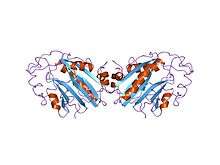DNA/RNA non-specific endonuclease
In molecular biology, enzymes in the DNA/RNA non-specific endonuclease family of bacterial and eukaryotic endonucleases EC 3.1.30.- share the following characteristics: they act on both DNA and RNA, cleave double-stranded and single-stranded nucleic acids and require a divalent ion such as magnesium for their activity. A histidine has been shown to be essential for the activity of the Serratia marcescens nuclease. This residue is located in a conserved region which also contains an aspartic acid residue that could be implicated in the binding of the divalent ion.[1]
| Endonuclease_NS | |||||||||
|---|---|---|---|---|---|---|---|---|---|
 identification of the serratia endonuclease dimer: structural basis and implications for catalysis | |||||||||
| Identifiers | |||||||||
| Symbol | Endonuclease_NS | ||||||||
| Pfam | PF01223 | ||||||||
| Pfam clan | CL0263 | ||||||||
| InterPro | IPR001604 | ||||||||
| PROSITE | PDOC00821 | ||||||||
| SCOPe | 1smn / SUPFAM | ||||||||
| CDD | cd00091 | ||||||||
| |||||||||
Notable members of the family include Serratia marcescens NucA and human Exonuclease G.
References
- Friedhoff P, Gimadutdinow O, Pingoud A (August 1994). "Identification of catalytically relevant amino acids of the extracellular Serratia marcescens endonuclease by alignment-guided mutagenesis". Nucleic Acids Res. 22 (16): 3280–7. doi:10.1093/nar/22.16.3280. PMC 523719. PMID 8078761.
This article is issued from Wikipedia. The text is licensed under Creative Commons - Attribution - Sharealike. Additional terms may apply for the media files.